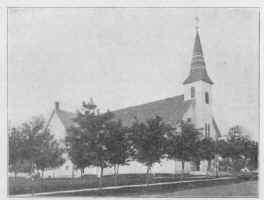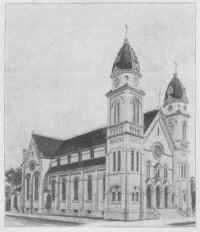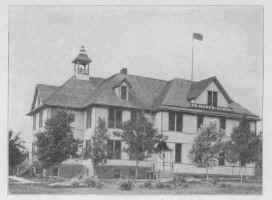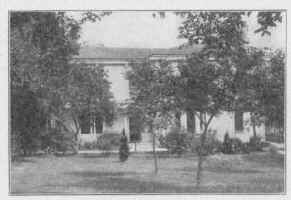The first Catholic settlers of this year and the
next few years were Peter Wagner, Matt Kontz, F. Hansen, M. and N. Probst, P.
and H. Frantzen, N. Nemmers, Theo. Gehlen, M. and J. Biever, F. Krausert, J.
Drebs, F. Arens, P. Allen, M. Kinney, J. Steichen, H. and P. Goebel, J. and G.
Gerst, J. and N. Schneider, N. Kellen, P. Engeldinger, N. and P. Schaul, J. and
P. Gaul, N & J. Henrich, M. Streff, J. and N. and Theo. Klein, N. Reiter, M.
Schroeder, N. Koob, M. Eischen, H. Schnee, N. Ludowisse, J. and N. Pfeffer, J.
and F. Homan, J. Tritz and some others whose names the writer could not
ascertain.
The nearest place of Catholic worship was in LeMars,
and it was edifying to see the sturdy pioneers hitch up their oxen and thus
drive the long way to LeMars. On Christmas day they had to start about midnight,
in order to reach LeMars in time for divine service.

THE OLD ST. MARY'S CHURCH
The first mass in Sioux County was celebrated
in Kilburg's store in the present town of Alton, then called East Orange,
October 3, 1873, when Frank Koob was baptized. Peter Wagner acted as server and
N. Nemmers and N. Koob were chanters. After that date mass was occasionally
celebrated in the farm houses and afterwards in the school houses-especially in
Wagner's-by Revs. Lynch of Sheldon, Lenihan of Sioux City and Meis of LeMars.
When the churches in LeMars and later on in Hosper(s) were built the pioneers
around East Orange contributed of what little they had.
When the "grasshopper or starving time" had
passed new emigrants came from the east and soon the people talked about
building a church. However, it was not until the year 1881 that St. Donatus
church on the southwest corner of section eighteen, East Orange Township, was
erected-N. and J. Henrich being the builders. A violent storm wrecked the
building, but it was re-built at once and dedicated September 22, 1881, by Rev.
Meis of LeMars.

THE NEW ST. MARY'S CHURCH
The church was seventy by thirty-seven, quite
a respectable undertaking for that time when the settlers were poor and could
ill afford to bring great sacrifices. But they had the zeal of the early
Christians.
In the meantime some Catholics had made their homes in
the little town of East Orange. Naturally they desired to have a church in town.
Rev. U. Frey was sent in the summer of 1883 with instructions to form a
congregation in the town and build a church. Consequently the old St. Mary's
church was put up in the fall of the same year. The dimensions were seventy by
forty. The residence of Mr. Beach was bought for a parsonage. Father Frey
furnished the church with an altar, pews, stations, etc. In October, 1884, Rev.
G. H. Luehrsmann was appointed pastor of the growing congregation. For eight
years Rev. Father Luehrsmann devoted his energies to the upbuilding of St.
Mary's church and his strenuous efforts were not in vain. He bought part of the
cemetery west of the church, furnished the church with bells and vestments,
built an addition of forty by twelve to the church and opened the first
parochial school in northwestern Iowa. In 1886 Bishop Marty of Sioux Falls
dedicated the church and blessed the bells, When-in the fall of 1892-Rev. P.
Peschong was named the successor of Father Luehrsmann, St. Mary's parish was one
of the best in this part of Iowa.
During the short pastorate of Rev. Peschong-January
1893 to October 1894-an effort was made to build a new parsonage, but the plans
did not mature and a new school was built instead.
In October, 1894, the present pastor, Rev. F. J. Brune,
took charge of St. Mary's Church. Many changes and improvements have been made
during his pastorate. In the fall of 1896 the old landmark known as "the
prairie church" was taken down and the material used during the following
summer in remodeling and enlarging St. Mary's Church, which is at present one of
the largest church buildings in Sioux County. The total length is 134 feet, the
width in the transept sixty feet-giving a seating capacity of fully eight
hundred. By use of chairs one thousand worshipers can be accommodated. The
church is completely furnished with stained glass windows, beautiful altars,
statues and banners, pipe organ and furnace heat.
In 1902 the cemetery was enlarged, the parsonage remodeled, a gas plant
installed which brilliantly lights church, school and parsonage. During the past
few weeks a beautiful set of new Stations-imported from Germany at the cost of
$1,600-was placed in the church.
One hundred and seventy families-a total of about one
thousand souls-constitute the membership. The church and parsonage and the large
parochial school are situated on one of the highest points in Alton-affording a
fine view of the city and the surrounding county.

ST. MARY'S SCHOOL
Grounds and buildings of the congregation
represent a value of about $50,000 and are clear of any incumbrance. The sermons
are given in both German and English. The financial management is in the hands
of Father Brune and the following committee: B. Pottebaum, Paul Henkels, Jacob
Klein, Geo. Friedmann, B. Malrose, J. H. Geraets.
The new church, for the building of which active
preparations are now made, will be of Romanesque architecture, of press brick
and stone, with two towers of same height, grand front, beautiful clerestory and
fine vestibule and gallery. Extreme length 145 feet, width of front 68 feet,
width of transcept 70 feet, main width 58 feet. Martin Heer of Dubuque, is the
architect. The foundation is to be built this year, and the entire structure is
to be ready for use some time in the fall of 1908. The Building Committee
consists of Very Rev. Brune, P. Bamberg, A. Delperdan, P. Frantzen, Geo.
Friedmann, J. H. Geraets, P. Hansen, P. Henkels, M. Herrig, J. Klein, B. Malrose,
M. Minten, B. Pottebaum, J. Schneider, N. Schroeder, J. P. Tritz.
ST. MARY'S SCHOOL.-One of the principal duties of a
Christian is the proper education of his children. Hence at an early date the
efforts of the pioneers of St. Mary's Church were directed to the establishing
of a Catholic school. When Rev. Father Luehrsmann had been appointed pastor of
St. Mary's, his first care was the opening of a parochial school. In the summer
of 1885 a stable was remodeled to serve as the first Catholic school in
northwestern Iowa. In September, 1885, three Sisters of St. Francis took charge
of the same. It was indeed a small beginning with some twenty-five children.
Great were the sacrifices required. To meet the expenses of the school a tuition
of $1.50 had to be paid for each pupil. But the good people paid gladly in order
to bring up their children in morality and the atmosphere of their religion. The
efforts of Father Luehrsmann, the Sisters and the congregation were crowned with
success. In the next year an addition was necessary. Plain indeed was the
building, but it was the cornerstone of the present prosperity of the parish.
The builders of the first school built well and wisely. New sacrifices were made
by the members of St. Mary's in the summer of 1893, when the east half of the
present large parochial school was erected. The attendance had grown to over one
hundred and the school continued to flourish so that in 1899 it became necessary
to put up a large addition. St. Mary's of today is one of the largest Catholic
schools in the state. Its extreme dimensions are sixty-eight feet by eighty-to
feet, with basement, two stories and nicely finished attic. The basement
contains the kitchen, dining rooms, furnace rooms, coal bins, etc. The first
story has 2 class-rooms, living apartments for the Sisters and a spacious hall,
which in winter serves as a chapel for the services on week days.

ST. MARY'S PARSONAGE
In the second story there are four large
class rooms, a spare room for visiting Sisters and a fine collection of natural
curiosities and minerals-the so-called "Museum." The third story or
attic is divided into sleeping apartments for the Sisters and boarding pupils.
Two big furnaces distribute the necessary heat throughout the entire building,
the city waterworks furnish a good supply of fresh water. Thus St. Mary's is
thoroughly equipped to impart a thorough education both religious and secular. A
high school department was added in 1900 where the branches commonly taken in
high schools are taught by efficient instructors. The number of pupils for the
past year was 272. Upon completion of new church the old church will be
remodeled, partly for a residence of the Sisters, partly for a spacious hall.
THE REFORMED CHURCH OF
ALTON,IOWA
Rev. A. M. Van Duine.
The first preaching
service at this place was conducted about the middle of March, 1877, in the
school house, by the Rev. S. Bolks of Orange City. At the close of this meeting
plans were discussed for the organization of a reformed church at this place.
Messrs. D. Gleysteen, H. De Kraay and B. Smit were appointed a committee to
circulate a petition, and see how many persons would unite with the new
organization to be formed. The result was that twenty-seven families signed the
petition for organization. This was sent to the consistory of the First Reformed
Church of Orange City, Iowa, and by it to the classis of Illinois.
This petition was granted and the Rev. S. Bolds and
Elder S. Muilenburg were appointed a committee to organize said petitioners into
a Reformed Church at East Orange, which name was afterwards changed to Alton. On
the 18th day of May, 1877, the committee met with the petitioners, in the public
school house, and organized them into the Reformed Church of East Orange, Iowa.
This name was changed March 27, 1882, to the Reformed Church of Alton, Iowa. The
meeting was opened with prayer and singing from Psalm 133, verse 1, and a short
address based on St. John 17, by the Rev. S. Bolks, after which the following
persons were received in full communion of the church: Mr. Boot Smit and wife,
R. Klersmo, Mr. D. Gleysteen and wife, Clazine Van der Linde, Mr. Ryk Sneller
and wife, Naaltje Juffers, Mr. Hermanus De Kraay and wife, Hendrika Sardina
Dingemans, Mr. Adrian M. Van der Berg and wife, Elizabeth Rysdam, Mr. Willem K.
Scholten and wife, Hermana Scholten, Mr. Jan Scholten, Mr. Rokus Vos and wife,
Antje Van Tol, Mr. Willem Willemsen, Mr. Evert, J. G. Bloemendal, Mr. G. J.
Hofmeyer and wife, Gerrit Dina Nyenhuis, Mr. H. Woertink and wife, Juntje
Vedders, Mr. Jan S. Drymvet and wife, G. H. Hans Kamp and Cornelia De Kraay.
These members immediately proceeded to the election of
the first consistory. As elders were elected: Messrs. B. Smit, W. K. Scholten,
R. Sneller and R. Vos. As deacons: A. M. Van den Berg, D. Gleysteen, G. H.
Hofmeyer and H. De Kraay. These persons were at this same meeting duly installed
severally in the offices for which they were elected.
According to resolution, the first consistory meeting of the church was held May
26, 1877. The congregational meeting was closed with Psalm 122, verse 3, and
prayer by Elder H. Muilenburg of Orange City.
On the 24th of August, 1877, the church extended its
first call to the Rev. J. W. Wornshuis of Clymer, N. Y., who was at that time in
their midst by invitation. This call was accepted Feb. 16, 1878, and the brother
was installed over said church Nov. 19, 1878, and served it from June 9 of the
same year until Aug. 22, 1886. On Oct. 8, 1877, this church resolved to build a
parsonage, which was built during the same fall.
Continued
on Page 8
|